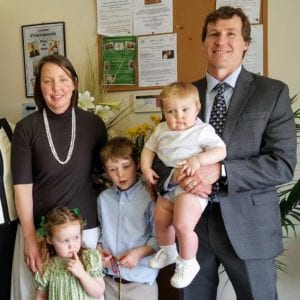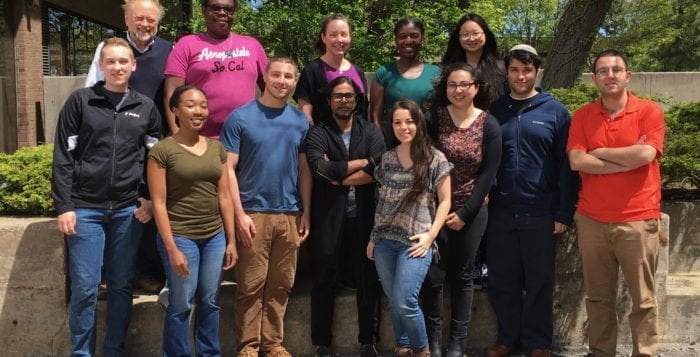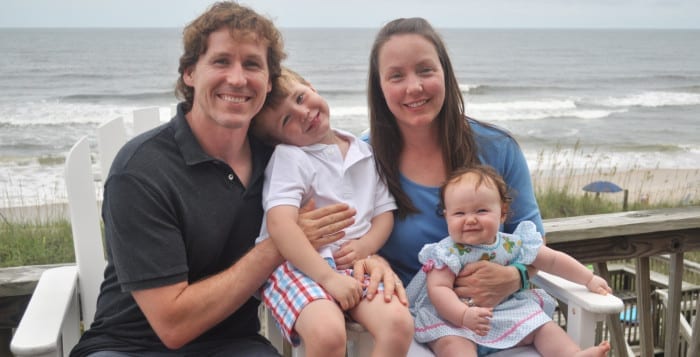By Daniel Dunaief
It was in the back of Elizabeth Boon’s mind for the last decade. How, she wondered, could the switch that is so critical to life not be there and yet still allow for normal functioning? She suspected that there had to be another switch, so the associate professor in the Department of Chemistry at Stony Brook University, spent the last five years looking for it.
Sure enough, she and graduate students including Sajjad Hossain, found it.
Bacteria, like so many other living creatures, need to have a way of detecting nitric oxide gas. At a high enough concentration, this gas can kill them and, indeed, can kill other living creatures as well, including humans.
Nitric oxide is “toxic to any organism at a high enough concentration,” Boon said. “Most organisms have ways of detecting high concentrations … to avoid toxic consequences.” Other research had found a way other bacteria detect this toxic gas through a system called H-NOX, for heme nitric oxide/ oxygen binding protein.
When bacteria live together in colonies called biofilms, many of them typically rely on a signal about the presence of nitric oxide from the H-NOX protein. And yet, some bacteria survived without this seemingly critical protein. “We and others have shown that H-NOX detection of nitric oxide allows bacteria to regulate biofilm formation,” Boon explained.

Named the nitric oxide sensing protein, or NosP, Boon and her team discovered this alternative signaling system that has some of the same functional group as the original mechanism. When activated in one bacteria, the Pseudomonas aeruginosa, this signaling mechanism causes biofilm bacteria to react in the same way as they would when an H-NOX system was alerted, by breaking up the colony into individuals. Using a flagella, an individual bacteria can move to try to escape from an environment containing the toxic gas.
Nicole Sampson, a professor of chemistry at Stony Brook University, suggested that this work was groundbreaking. While some biofilms are benign or even beneficial to humans, including a biofilm in the human gut, many of them, including those involved in hospital-borne infections, can cause illness or exacerbate diseases, particularly for people who are immunocompromised. Bacteria in biofilm are difficult to eradicate through drugs or antibiotics. When they are separated into individuals, however, they don’t have the same rigid defenses.
“They are resistant to most forms of treatment” when they are in biofilms, Boon said. “If we could get the bacteria to disperse, it’d be much easier to kill them. One of the hopes is that we could develop some sort of molecule that might loosen up the film and then we could come in with an antibiotic and kill the bacteria.”
Boon and her team published their results on the cover of the magazine ACS Infectious Disease, where they presented evidence of what they describe as a novel nitric oxide response pathway that regulates biofilm in the bacteria P. aeruginosa, which lack the H-NOX gene. The day the lab discovered this other protein, they celebrated with a trip for frozen yogurt at Sweet Frog.
In an email, Sampson said that finding the mechanism through which bacteria responds to nitric oxide “is important for developing therapies that target biofilms.”
While Boon is pleased that her lab found an alternative nitric oxide signaling system that answered a long-standing question about how some bacteria could respond to an environmental signal that suggested a threat to the biofilm, she said the answer to the question, as so many others do in the world of science, has led to numerous other questions.
For starters, the lab doesn’t yet know the structure of the NosP. “Not all proteins are immediately willing to crystallize,” Boon said. “We’re hopeful we’ll have a structure soon.” She knows it has a heme group, which includes an iron ion in the middle of an organic compound. That’s where the nitric oxide binds.
“We’d like to have the structure to piece together how that signal is relayed out to the end of the protein and how that gets transferred to other proteins that cause changes in behavior,” she said. The NosP is longer than the H-NOX protein, although they appear to have the same function.
Boon has also found that some bacteria have both the H-NOX and the NosP, which raises questions about why there might be an apparent redundancy. In organisms that have both proteins, it’s tempting to conclude that these bacteria live in a broader range of environments, which might suggest that the two systems react to the gas under different conditions. At this point, however, it’s too early to conclude that the additional sensing system developed to enable the bacteria to respond in a wider range of conditions.
Boon believes the nitric oxide system could be a master regulator of bacterial biofilms. “Detecting nitric oxide might be one of the first things that happen” to protect a bacteria, she said. The reason for that is that bacteria, like humans, use iron proteins in respiration. If those proteins are blocked by nitric oxide, any organism could suffocate.
Boon believes a multistep therapeutic approach might work down the road. She believes breaking up the biofilm would be an important first step in making the bacteria vulnerable to attack by antibiotics. She and her graduate students work with bacteria in the lab that generally only cause human disease in people who are already immunocompromised. Even so, her staff takes safety precautions, including working in a hood and wearing protective equipment.
Boon and her husband Isaac Carrico, who is an associate professor in the Department of Chemistry at Stony Brook University, have a 7-year-old son Cannon, a 3-year-old daughter Sheridan and a 1-year-old son Beckett. Boon said she and her husband are equal partners in raising their three children.
In her work, Boon is excited by the possibility of addressing new questions in this nitric oxide mechanism. “We’re trying to cover as much ground as fast as possible,” she said.






